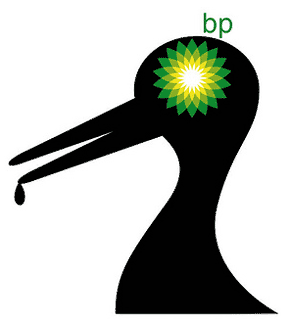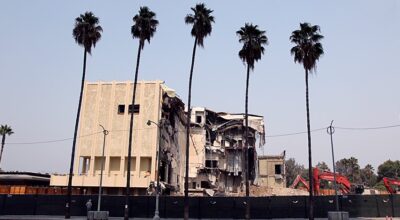BP’s Oil Slick: LACMA Woes

If you think the eerie green photograph shown at left is just another postmodern artwork to be found in the collection of the Los Angeles County Museum of Art (LACMA), then you are not too far off the mark. While the weird image was certainly not conjured up by one of today’s fashionable art stars, it is in a manner of speaking, one of LACMA’s most recent acquisitions, and it has been supplied by one of the museum’s leading benefactors.
In March of 2007, LACMA’s Director Michael Govan struck a deal with oil giant BP (British Petroleum). Govan agreed to accept a $25 million “donation” from BP that would help in the renovation of the museum, and in return the entry way on LACMA’s newly expanded campus would be christened, “The BP Grand Entrance.” At the time Govan touted BP as a “green” company, telling the Los Angeles Times that he accepted the oil company’s money because: “What was convincing to me was their commitment to sustainable energy (….) We won’t make the transition without the help and cooperation of these major corporations.”
Since that March 2007 deal I have unremittingly covered the oily relationship between LACMA and BP – and the story only continues to worsen. The above photograph is not part of LACMA’s collection, though it could be included in an exhibit that explores just exactly what a “commitment to sustainable energy” means to the museum and its director. In actuality the photo was taken by the U.S. Coast Guard, and it shows a broken underwater oil pipe that is presently spewing over 42,000 gallons of crude oil into the Gulf of Mexico per day. That particular oil drilling operation gone awry is run by none other than LACMA’s major patron, British Petroleum. LACMA has not acquired a work of art, but the stain of collaborating with one of the planet’s most rapacious polluters.
You may have heard about the tragic fire and explosion on the huge Deepwater Horizon oil rig located in the Gulf of Mexico, if not, ask Michael Govan about it. The oil rig was owned and operated by the Swiss based firm Transocean; however, its operations were under lease to British Petroleum. Transocean was drilling an exploration well for BP when the Deepwater Horizon rig exploded and sank on April 26, 2010 – killing eleven workers. The capsized rig, with a platform larger than a football field, broke away from the pipe that connected it to the oil well 5,000 feet below the ocean surface; the broken underwater drilling infrastructure is now pouring out 1,000 barrels of crude oil per day into the Gulf of Mexico. At the time of this writing, the growing oil slick covers well over 3,360 square miles of ocean, and there are fears the massive slick will affect the coastal communities of Texas, Louisiana, Mississippi, Alabama, and Florida.
BP’s enormous oil slick, less than 36 miles from the Louisiana coast, is directly threatening the Breton National Wildlife Refuge and the Delta National Wildlife Refuge. Located off the coast of Louisiana, Breton Refuge is the second oldest wildlife refugee in the U.S. Founded in 1904 by President Theodore Roosevelt, it is accessible only by boat and it provides habitat and colonies for over twenty-three species of seabirds and shorebirds. Delta Refuge is located at the mouth of the Mississippi River. Established in 1934, its 49,000 acres provides habitat to huge numbers of fish, mammals, reptiles, and birds. If the oil slick were to reach these nature reserves, the result would be a catastrophe of unparalleled dimension. As it is, BP’s oil slick will cause tremendous devastation to the fragile marine ecosystem found in the Gulf of Mexico, and untold numbers of fish, birds, mammals, and crustaceans that live in the Gulf will die.
The Gulf of Mexico oil slick confirms BP actually stands for “Big Profits” and not “Beyond Petroleum.” On April 27, as the U.S. Coast Guard struggled to contain the ecological disaster in the Gulf, BP posted a huge surge in its earnings – a phenomenal increase in profits from last year’s $2.39 billion to this year’s $6.08 billion. Now that BP is glutted with oil and flush with cash, perhaps LACMA’s Michael Govan can ask them for another “donation.” I am sure BP could use an excellent public relations gimmick right about now, so I would like to suggest that LACMA construct “The Grand Deepwater Horizon Exit Gate” as part of their new BP financed campus.
While Govan and BP run for political cover in the wake of the Gulf oil spill, they will not be alone in doing so. Just days after millions of people in the U.S. celebrated the 40th anniversary of Earth Day, what is left of the Deepwater Horizon oil rig is gushing crude into the Gulf in a slick so massive it is larger than the state of Rhode Island. NASA has photographed the gigantic slick from space. And what is the response from President Obama, especially since he has announced a plan to open over 500,000 square miles of U.S. coastal waters to oil drilling – including a vast area in the Gulf of Mexico that has never before been drilled? On April 23 President Obama’s spokesman Robert Gibbs alleged there is no reason to give up plans to expand offshore oil drilling, declaring; “In all honesty I doubt this is the first accident that has happened and I doubt it will be the last.” Perhaps when Michael Govan leaves LACMA in disgrace, he can get a job in the Obama administration.
_____________________________________________________________

Updates, May 20 through 29, 2010: On Saturday, May 29, the Associated Press reported that BP chief operating officer Doug Suttles admitted that BP’s “Top Kill” effort to stop the oil leak was a complete failure. Suttles commented, “This scares everybody, the fact that we can’t make this well stop flowing, the fact that we haven’t succeeded so far.”
On May 27, national and international media, taking information from BP and the Obama administration’s U.S. Coast Guard, reported that BP’s “Top Kill” effort to stop the torrent of oil from gushing into the ocean was a “success” and that “industry and government engineers had pumped enough drilling fluid to block oil and gas spewing from the well.”
Yahoo News and CBS News both reported that at President Obama’s May 28th press conference on a beach in Grand Isle, Louisiana, an event meant to show the president was “in control” of response efforts, BP bused in hundreds of temporary workers to clean-up oil off the beach. After Obama left the scene, BP dismissed the workers.
May 27, national and international media report the U.S. government’s pronouncement that the BP catastrophe is the worst eco-disaster in U.S. history – with U.S. Geological Survey scientists calculating that the broken BP pipeline is spewing more than one million gallons of crude a day into the Gulf of Mexico, the gusher will no doubt become the worst eco-disaster in world history. Starting on May 20, 2010, Greenpeace UK launched an art competition to redesign the BP corporate logo.
Updates, May 15, 2010: The U.K. Telegraph reported that President Obama’s Environmental Protection Agency gave BP permission to use massive amounts of a chemical dispersant underwater, despite there being no scientific knowledge regarding the ecological dangers posed by such a huge application of the toxic chemical known as “Corexit.” The New York Times reported that to date, BP has applied more than 400,000 gallons of Corexit in the Gulf of Mexico, and it has 805,000 gallons of the chemical on order. The New York Times also revealed that “of the 18 dispersants whose use EPA has approved, 12 were found to be more effective” than Corexit. The toxicity of the 12 alternatives was in some cases “10 or 20 times less” than Corexit. Nalco manufactures Corexit, and that company’s current leadership includes executives from BP and Exxon – LACMA and its director Michael Govan continue to remain silent regarding their ongoing financial relationship to BP.
UPDATES, May 5 through 14, 2010: A National Day of Protest against BP was called for May 12, 2010, with protests held in U.S. cities from Los Angeles to New York City – Both NPR and the New York Times have reported that scientists are saying the BP broken rig is spilling, not 5,000 barrels a day, but up to 100,000 barrels a day – Politico.com reported that President Obama has “received a total of $77,051” from BP over the last 20 years, making him “the top recipient of BP PAC and individual money.” – McClatchy Newspapers reports that “Since the Deepwater Horizon oil drilling rig exploded on April 20, the Obama administration has granted oil and gas companies at least 27 exemptions from doing in-depth environmental studies of oil exploration and production in the Gulf of Mexico.”
[ Friends of the Earth are asking people to sign their online petition calling for President Obama to abandon his plans for expanded offshore oil drilling. ]


